- Academy for Engineering and Technology, Fudan University, Shanghai, China
In multi-skill imitation learning for robots, expert datasets with complete motion features are crucial for enabling robots to learn and transition between different skills. However, such datasets are often difficult to obtain. As an alternative, datasets constructed using only joint positions are more accessible, but they are incomplete and lack details, making it challenging for existing methods to effectively learn and model skill transitions. To address these challenges, this study introduces the Seamless Multi-Skill Learning (SMSL) framework. Integrated within the Adversarial Motion Priors framework and incorporating self-trajectory augmentation techniques, SMSL effectively utilizes high-quality historical experiences to guide agents in learning skills and generating smooth, natural transitions between them, addressing the learning difficulties caused by incomplete expert datasets. Additionally, the research incorporates an adaptive command sampling mechanism to balance the training opportunities for skills of various difficulties and prevent catastrophic forgetting. Our experiments highlight potential issues with baseline methods when imitating incomplete expert datasets and demonstrate the superior performance of the SMSL framework. Sim-to-real experiments on real Solo8 robots further validate the effectiveness of SMSL. Overall, this study confirms the SMSL framework’s capability in real robotic applications and underscores its potential for autonomous skill learning and generation from minimal data.
1 Introduction
1.1 Background
In the field of robotic control, Reinforcement Learning (RL) has been proven to be an effective control method, particularly in legged robots (Lee et al., 2020; Kumar et al., 2021; Miki et al., 2022; Hou et al., 2024). Despite these successes, robots need to acquire complex skills and dynamically switch tasks to cope with fluctuating environments, presenting significant challenges to RL methods that rely on intricate reward designs. Imitation Learning (IL) enables robots to learn from expert datasets without the necessity for complex reward functions, thus allowing platforms such as quadruped robots to master a variety of motion skills (Li et al., 2023). However, IL is heavily dependent on the quality and completeness of the expert datasets (Ran and Su, 2024). When the expert datasets are of high quality, the integration of Generative Adversarial Networks (GAN) (Goodfellow et al., 2020) with RL (Sutton and Barto, 2018) in the Adversarial Motion Priors (AMP) (Peng et al., 2021) approach demonstrates its superiority. By training discriminators to differentiate between expert data and policy outputs, AMP encourages policy networks to produce similar state transitions, performing well on high-quality datasets. These datasets typically include physical information such as joint positions, velocities, accelerations, and torques, which are crucial for enhancing the effectiveness of IL.
Ideally, these datasets are obtained through high-precision motion capture equipment, but such devices may fail to capture all high-speed or complex movements. As an alternative, researchers generate high-quality expert data using trajectory optimization algorithms or deep RL methods in simulation environments. These approaches undoubtedly increase the initial preparation costs for IL methods. A simpler and less costly method involves acquiring joint position information from video recordings or by manually manipulating real robots. However, its effectiveness is reduced due to the lack of rich motion feature information. Moreover, when expert datasets contain skills of various complexities, the AMP method struggles to train a policy that learns all the skills in the dataset; it may learn some skills but also risk forgetting previously learned ones over extended training periods. It is more likely to primarily learn simple or mixed skills, which may not meet researchers’ expectations. To optimize the AMP approach, one potential method is to manually segregate various strategies within the expert dataset and employ separate networks to learn them, but this method requires extensive manual annotation and computational resources. When the skills to be imitated differ significantly in terms of similarity, they are referred to as Non-similar skills in this context. For example, in a quadruped robot, transitioning between quadrupedal and bipedal states is considered a Non-similar skill transition. If the expert dataset only contains these states without the transitions between them, simple IL methods become less effective in achieving the research objectives (Hussein et al., 2017). The challenge is more pronounced in scenarios requiring transitions between fundamentally different motion skills, making it difficult to effectively learn and transition between skills.
Non-similar skills refer to those with significant differences in motion characteristics. We employed simulation, t-SNE, and Dynamic Time Warping (DTW) techniques (Müller, 2007) to visually depict the differences between motion skills. In Figure 1, we selected three skills simulated using the Isaac Gym platform to demonstrate the differences in motion characteristics between Similar and Non-similar skills. ‘wave’ and ‘trot’, both based on a quadrupedal stance, are categorized as similar skills. Conversely, ‘trot’ and ‘biped’, based on quadrupedal and bipedal stances respectively, are considered Non-similar skills. Figure 2 presents t-SNE plots that display the state trajectories of two skills (‘wave’, ‘trot’) from the Cassie expert dataset, compared with the state trajectories from our Non-similar expert dataset (‘biped’), where the trajectories include joint position information. It can be observed that the trajectories of Similar skills (‘wave’, ‘trot’) exhibit some overlap in the state space, providing favorable conditions for designing strategies capable of mastering multiple skills. However, the Non-similar skill (‘biped’) does not overlap with the other skills, which increases the training complexity of multi-skill strategies. We also used DTW to quantify the distances between Similar and Non-similar skills, as shown in Table 1. We calculated the distances between the state trajectories of different skills, with smaller values indicating greater similarity between skills. The gaps between Non-similar skills are significantly larger than those between Similar skills.
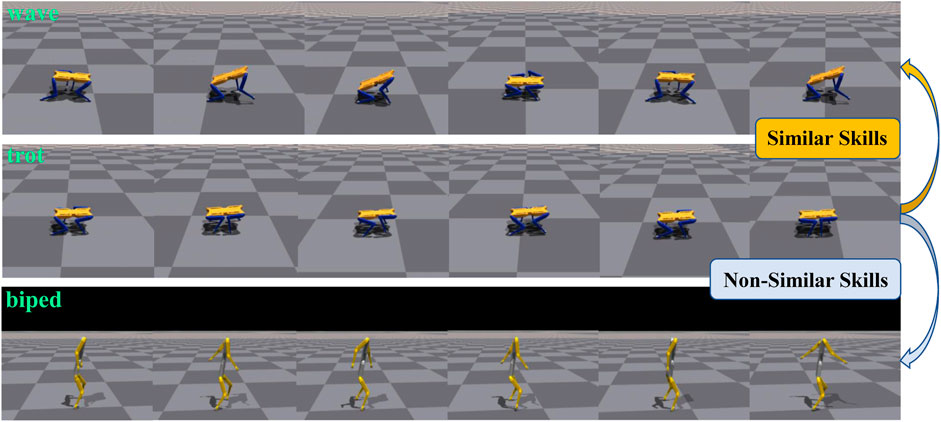
Figure 1. Simulation description of Similar skills and Non-similar skills. Three motor skills of“ wave” (Top),“ trot” (Mid) and “biped” (Low) are selected to show the characteristics of Similar skills and Non-similar skills.
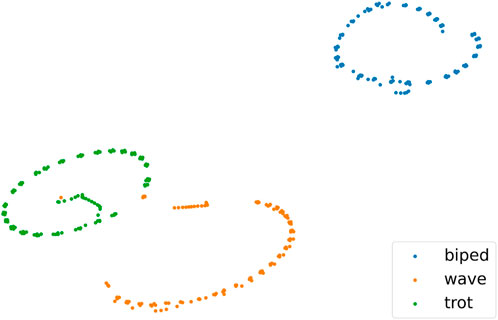
Figure 2. State trajectory distribution diagrams for Similar and Non-similar skills: Shows the state trajectory distribution of Similar and Non-similar skills, including joint position information for “wave”, “trot”, and “biped”.
Given these challenges, effectively learning distinct skills and transitioning from an expert dataset containing only joint positions has emerged as a critical research issue. This involves one of the core issues in RL: Avoid catastrophic forgetting. To address this issue, we focus on the following two key questions in this research: (1) How to ensure that both complex and simple Non-similar skills receive appropriate training opportunities within a unified policy network, thus achieving comprehensive skill mastery? (2) How to compensate for missing states between skills within the same policy network to achieve more accurate and effective skill switching, thereby improving policy performance and ensuring seamless transitions between different actions?
1.2 Contributions
To address these problems above, this paper introduces Seamless Multi-Skill Learning (SMSL), a method for learning multi-non-similar skills with limited data. This approach incorporates an adaptive skill selection mechanism to deal with expert datasets with Non-similar skills expert datasets. This selection mechanism ensures that skills of various difficulties can be sufficiently trained and achieve comprehensive mastery of the skills. It also effectively extracts skills and generates natural transitions between Non-similar skills by leveraging historically successful states. The contributions of this method can be summarized as follows:
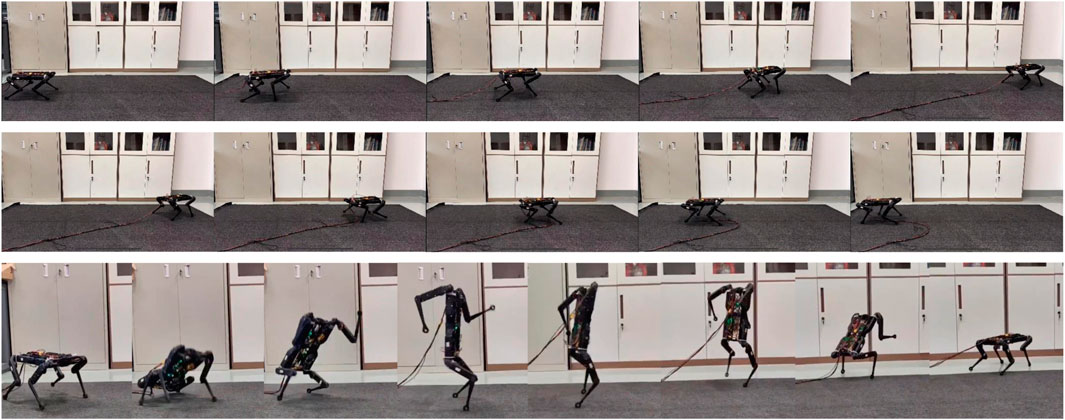
Figure 3. Sim-to-real task is conducted on the Solo8 robot, involving moving forward (Top) and backward (Mid) in a quadrupedal walking state, and transitioning from a quadrupedal state to a bipedal walking state (Low). Our approach uses a single policy to manage the transition between quadrupedal and bipedal states.
2 Related work
Quadruped robots enhance the flexibility and efficiency of task execution by mastering multiple skills to cope with the complexity of task environments (Aziz et al., 2022). Due to the complexity of controlling quadruped robots, traditional RL methods encounter challenges related to the complexity and potential imprecision of reward design in multi-skill tasks. As an efficient alternative, IL enables quadruped robots to quickly master complex skills by observing and replicating expert behaviors, making it particularly suitable for complex tasks that require the rapid integration of multiple skills (Billard et al., 2008; Torabi et al., 2019; Gavenski et al., 2024; Oh et al., 2018).
Imitation learning has seen a series of innovative results in recent research on quadruped robot motion skills. Generative Adversarial Imitation Learning (GAIL) (Ho and Ermon, 2016) offers an effective framework for imitation learning in high-dimensional environments by learning from expert data containing state-action pairs without relying on explicit cost functions. AMP (Peng et al., 2021) extends this by guiding robots to complete tasks using expert data and the task environment, even with only state trajectory data. Based on AMP, (Escontrela et al., 2022; Wu et al., 2023), applied the AMP method for robust and agile quadruped walking on complex terrains. (Vollenweider et al., 2023). developed a Multi-AMP structure for multi-skill strategies, pairing each expert dataset with its own generative adversarial network. However, generative adversarial networks can experience mode collapse when handling numerous, unlabeled datasets and skills. To address this, Cassi (Li et al., 2023) introduced a more effective approach integrating generative adversarial networks and unsupervised skill discovery techniques, enabling policy to imitate skills from expert data and maximizing mutual information between skills and a latent variable
Experience replay is an extremely efficient strategy guidance technique in RL. It enables robots to learn under conditions of limited samples, thereby enhancing policy learning efficiency (Yang et al., 2024). This technique balances exploration and exploitation, avoiding ineffective trial-and-error processes and catastrophic forgetting (Lin, 1992; Mnih et al., 2015; Schaul et al., 2015). Studies like (Peng et al., 2018; Li et al., 2023) introduce expert datasets into the experience replay buffer to initialize robots. During initialization, the robots’ state may be sampled from the expert dataset or generated randomly. However, these methods depend on the expert datasets’ prior knowledge. Limited or non-diverse datasets can hinder the strategies’ adaptability to various states in complex environments (Rajaraman et al., 2020). This dependency weakens the generalization of the policy in new environments and may lead robots to replicate errors or suboptimal behaviors, limiting the effectiveness of the policy and the robot’s adaptability and robustness (Cao et al., 2024; Lan et al., 2023) introduces the Self-Trajectory Augmentation (STA) technique, which dynamically collects and integrates excellent historical trajectories generated by the robot during training. This addresses the aforementioned issues by expanding the diversity and coverage of the dataset. (Messikommer et al., 2024). demonstrates that strategically selecting and utilizing past experienced states to initialize robots enhances performance in complex tasks. To our knowledge, our method introduces the STA approach within the AMP framework for the first time, reusing excellent historical states to effectively avoid catastrophic forgetting in multi-skill learning, thereby enhancing the agent’s learning process.
3 Preliminaries
In this work, the environment is modeled as an infinite-horizon Markov decision process (MDP), defined by the tuple
3.1 Adversarial Motion Priors framework
Currently, frameworks that integrate GAN and RL methods are widely used in the field of IL. We have opted to use the AMP framework to emulate the general motion characteristics found in these expert datasets. Similarly to Escontrela et al. (2022), the imitation discriminator
where the last term represents the non-zero gradient penalty for state transitions from the expert dataset, with
4 Methods
4.1 Overview
Our goal is to learn various motion skills from an expert data set that lacks complete information and to achieve transitions between these skills at any moment. To achieve adaptive training frequencies for skills of varying difficulty, we have designed a command selector denoted as
where
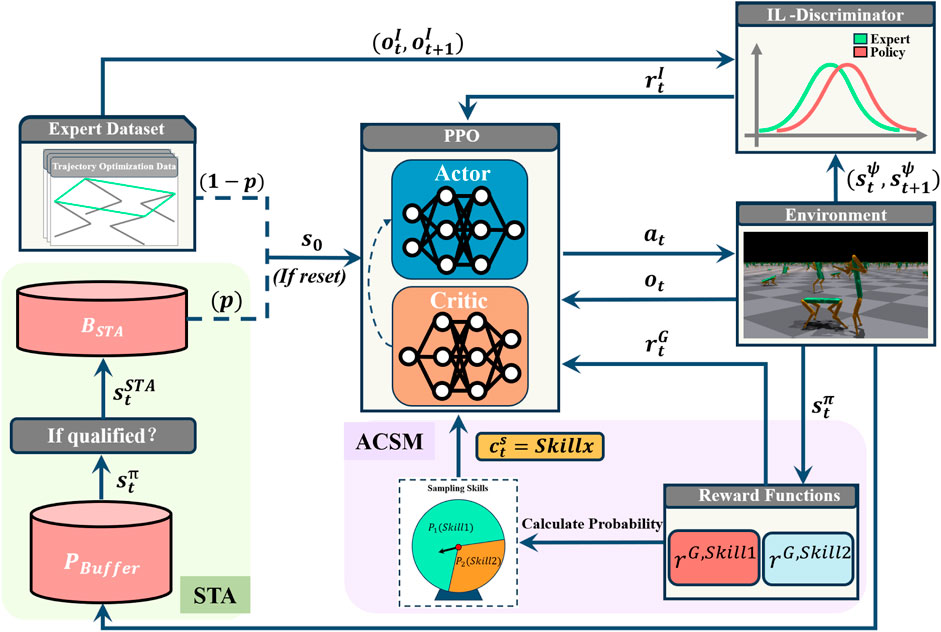
Figure 4. Method Overview. The system consists of two key components that work collaboratively to facilitate efficient skill learning: Adaptive Command Selection Mechanism (Purple) and Self-Trajectory Augmentation module (Green). Adaptive Command Selection module intelligently selects the optimal command by weighing the rewards of different skills, thereby balancing the opportunities for skill training.
4.2 Adaptive Command Selection Mechanism (ACSM)
During the training process for quadruped robots, four-legged walking postures often receive higher rewards, while bipedal standing postures tend to result in frequent falls in the initial stages of training due to the agent’s difficulty in maintaining balance, leading to lower rewards. Without constraints, the agent may tend to learn those simpler, higher-reward skills. Therefore, in the training process of multi-skill strategies, it is crucial to balance the training among skills of different difficulty levels to ensure that each skill reaches a satisfactory performance level. Thus, we aim to implement a control mechanism that allocates training resources based on the performance of each skill, ensuring a balanced development of skill training.
In RL, the goal reward value at each timestep,
where
Consequently, the performance evaluation metric
4.3 Self-trajectory Augmentation (STA)
When training for transitions between Non-similar skills, we face a challenge: the lack of transitional actions between skills in the datasets. To enable the agent to smoothly transition from the current skill to the target skill upon receiving a skill-switch command, we propose the addition of new states to guide the agent toward the target skill transition. Drawing on the concept of the STA method, a new buffer
A good state is one that allows for large rewards to be obtained in subsequent states. Therefore, we not only value the immediate rewards for the agent but also the long-term value of the state. We use the weighted average value
where
4.4 Goal reward function
Although imitation reward in Equation 2 offers advantages in simplifying the policy learning process, the GAN (LSGAN) method is not sensitive to expert trajectories and their surrounding state space areas Li et al. (2022). Therefore, relying solely on it as the only reward for skill learning does not accurately learn skills. For example, when training robots to perform quadrupedal and bipedal walking, relying on imitation rewards, especially excessive imitation rewards, may lead the agents to learn an unintended mix of actions. This indicates that when training with incomplete expert datasets, to avoid falling into local optima and to enable more targeted exploration, it is necessary to incorporate additional reward mechanisms to guide the learning of the policy, ensuring that agents can learn more accurate and natural behavior patterns.
4.4.1 Quadrupedal motion state
4.4.1.1 Quadruped gait reward function
When a quadruped robot learns to move forward or backward, it can easily fall into a suboptimal pattern of hopping, which is not the desired method of movement. We want the robot’s gait to mimic that of real quadruped animals, using an alternating gait for progression. Naturally, this leads to the consideration of imposing constraints on the robot’s gait. The design of the quadrupedal movement’s gait is as follows:
where
where
4.4.1.2 Quadruped leg-lifting reward function
To encourage the agent to lift its feet, the Isaac Gym simulation environment provides the foot elevation
where
4.4.1.3 Quadruped velocity tracking reward function
To encourage the agent to track velocity, the following reward function (Equation 11) is used:
where
Based on the above, the total goal reward for the quadrupedal state can be summarized as follows (Equation 12):
4.4.2 Bipedal motion state
Due to the absence of expert datasets for the transition from quadrupedal to bipedal motion states, it is necessary to incorporate a reward function that facilitates the transition to a bipedal state, compensating for the sparsity of the rewards during the skill switch.
4.4.2.1 Bipedal gait reward function
The reward function for gait transition in the bipedal state is identical to that of the quadrupedal state, so the expression will be omitted. Gait design is as follows:
The sequence of foot placement in the gait is the same as in the quadrupedal state. Unlike the quadrupedal state, the bipedal gait transition is effective only when the robot is capable of maintaining a stable bipedal stance. To adjust the reward value and encourage the robot to maintain a standing posture and gait, we assess the robot’s base pitch angle and monitor the foot contact states and heights during simulations. The formula is designed as follows (Equations 13, 14):
where
From this, we can derive the following Equation 15:
where
4.4.2.2 Bipedal velocity tracking reward function
This reward function (Equation 16) is similar to the quadrupedal state’s velocity tracking, but differs in that the bipedal state only tracks forward direction velocity:
4.4.2.3 Bipedal base reward function
The purpose of this reward function is to make the base height of the bipedal robot as close to the set target height as possible. This reward function (Equation 17) is similar to the quadrupedal state’s velocity tracking, but differs in that the bipedal state only tracks forward direction velocity:
The current base height
Based on the above, the total goal reward (Equation 18) for the bipedal state can be summarized as follows:
5 Experiments and results
We primarily address two questions: 1) To verify whether using the STA method can enhance learning efficiency and improve policy performance when the motion feature information in the expert dataset is incomplete. 2) To validate whether the adaptive skill command module can effectively balance the training of different skills.
We utilize the Isaac Gym simulation platform Makoviychuk et al. (2021) to parallelize 4,096 environments and employ the Proximal Policy Optimization (PPO) algorithm Schulman et al. (2017) for RL. Our experiments are conducted in two phases. Firstly, we use the Cassi method as a baseline to validate the effectiveness of STA. Subsequently, we evaluate our method, SMSL, in both simulation and on the real-world Solo8 robot Grimminger et al. (2020). As shown in Figure 3, our method was successfully deployed on the real robot. With a single policy, it not only learns non-similar skills but also autonomously generates transition motions. In the experiments, the robot demonstrated forward and backward movements in a quadrupedal stance, bipedal locomotion, and smooth transitions between quadrupedal and bipedal states. The configurations of the SMSL algorithm are shown in Table 2.
5.1 Versatility of STA modules
In the experiments, we used the vanilla Cassi method as a benchmark, excluding base velocity and joint velocity information from the imitation learning dataset because these velocity data are not directly observable. However, we retain the information of the quaternion and joint position, which can be obtained through simple measurement methods in the real world. We compare its performance before and after the incorporation of the STA method. The STA buffer is designed to store favorable features such as joint position, joint velocity, and base velocity from historical trajectories. This information will be used during the initialization phase of the environment. We design a series of agents that switch skills in the “trimesh” terrain within the Isaac Gym environment, and assess the performance of the policy by monitoring the survival rate of the agents. The experimental setup includes 500 agents starting from the same point, with each pair of skills forming a combination. Agents automatically switch skills after 500 timesteps, with a total timestep length of 1,000. If an agent resets during the experiment, we consider this as the agent ‘dying’.
During the initialization phase of the Cassi algorithm, 85% of the samples are selected from the expert dataset, while 15% are randomly generated. Figure 5a displays the survival rates of agents in “trimesh” terrains using the Cassi method via a heatmap, where the expert dataset includes complete motion characteristics of the skills. Figure 5b (Cassi (pos)) and (c) (Cassi (STA)) both show scenarios after removing velocity information, with (c) specifically illustrating the application of the STA method in the with random initialization. Despite the removal of velocity information, the STA method still improves the survival rates of agents on untrained “trimesh” terrains, thereby enhancing the generalization of the strategy. Comparing the three methods, the survival rate for ‘wave’ is consistently low, mainly due to the skill’s intrinsic properties. The wave-like nature of its base motion trajectory increases the likelihood of contact with the ground in “trimesh” terrains, resulting in a lower survival rate. Despite some skill pairs showing slightly higher survival rates in Figure 5b, this may be due to the lack of a strict one-to-one correspondence between commands and skills, leading to additional training opportunities for some skills. Detailed analysis and data will be presented later in the text.
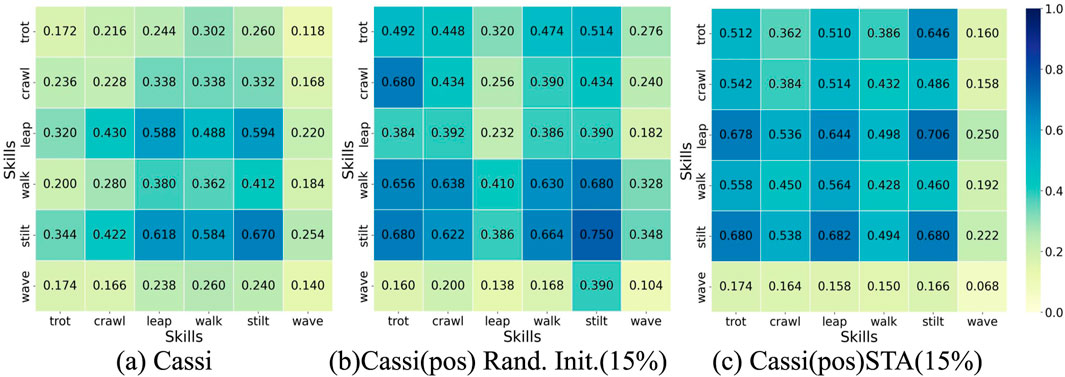
Figure 5. Agent Survival Rate Heatmap. The darker the shade of blue, the higher the survival rate for that pair of skills. Rand. Init. Stands for Random Initialization. (a) represents the original Cassi method. (b) represents the original Cassi method where the reference dataset retains only the robot’s joint position information, and the random initialization sampling probability is set to 15%. (c) represents the original Cassi method, where the reference dataset retains only the robot’s joint position information, and the STA method is introduced with a sampling probability set to 15%.
We extract state trajectories of six skills from the initial strategy of the Cassi algorithm and constructed a baseline dataset for comparative analysis. Using DTW technology, we calculate the distances between each skill trained by the Cassi (pos) method and the Cassi (STA) method and their corresponding skills in the baseline dataset. Ideally, each command should form a one-to-one correspondence with a specific skill. As shown in Figure 6a, when imitating the expert dataset, the mapping between skills and commands has errors due to the absence of some motion feature information. Specifically, in Figure 6a, command “0″ maps to two skills, “trot” and “leap,” while skill “stilt” corresponds to two different commands, “1″ and “2″ Theoretically, this could result in skill “stilt” receiving more training opportunities, and the data in the figure supports this view, showing it has the highest survival rate. Furthermore, Figure 6b displays the strategy trained by the Cassi (STA) method in the context of incomplete information from the expert dataset. Even under conditions of missing information, this method still manages to achieve a one-to-one correspondence between skills and commands. Additionally, the data in the figure indicates that the strategy trained by the Cassi (STA) method exhibits a relatively uniform distribution in terms of survival rates, meaning that each skill received balanced training opportunities.
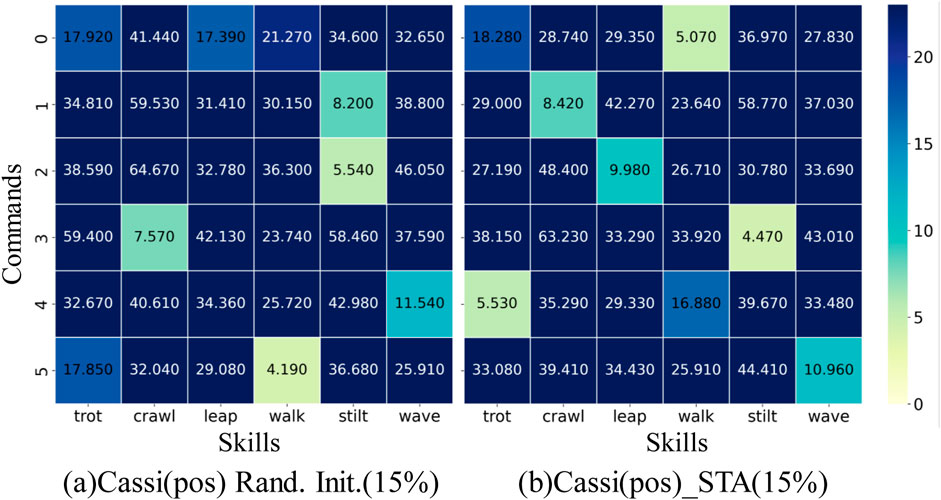
Figure 6. Skills-Commands Correspondence Diagram. The y-axis lists six commands, while the x-axis represents the skills in the expert dataset. The depth of the color indicates the level of similarity between the skills and commands; the darker the color, the lower the similarity. Ideally, each command should correspond to the lightest color block, indicating an exact match between the skill and the command. Similarly, each skill should also have only one light color block, ensuring a one-to-one correspondence between skills and commands. (a) represents the original Cassi method where the reference dataset retains only the robot’s joint position information, and the random initialization sampling probability is set to 15%. (b) represents the original Cassi method, where the reference dataset retains only the robot’s joint position information, and the STA method is introduced with a sampling probability set to 15%.
In the final test, we assess the resilience of the Cassi (STA) method relative to the original Cassi method in the face of observational disturbances. In the simulation environment, we introduce random additive noise to the observations of joint positions and joint velocities, with ranges of
5.2 Versatility of ACSM modules
This experiment is designed to validate the effectiveness of the skill-adaptive module proposed in Section 4.2. Through meticulously designed experiments, we are able to observe and analyze the actual performance of the module during training, thereby evaluating its contribution to multi-skill learning. As shown in Figure 7, the experiment presents the variation in skill sampling probabilities over 5,000 iterations of training using the SMSL method. It is evident that at the outset of training, both skills are sampled with relatively high probabilities due to their low initial reward values. As the number of iterations increases, the quadrupedal trotting skill—owing to its inherent stability and relatively simple control requirements—becomes easier for the agent to learn and master, leading its sampling probability to quickly drop to approximately 50%. In contrast, the bipedal skill, characterized by greater control complexity and higher balance demands, is more challenging to learn; thus, in the early stages of training, its sampling probability is set relatively higher than that of the quadrupedal skill to ensure sufficient exploration and learning. Notably, to prevent the policy from exclusively focusing on the more difficult skill and suffering from catastrophic forgetting of the simpler one, a minimum sampling probability of 50% is maintained for each skill. This design guarantees that all skills receive adequate attention during the training process, thereby achieving comprehensive and balanced skill acquisition.

Figure 7. Variation in Skill Sampling Probabilities. The blue curve illustrates the sampling probability dynamics for the quadrupedal locomotion skill “Trot,” while the red curve corresponds to the bipedal locomotion skill “Biped.”
5.3 Ablation studies
We conduct a detailed analysis of the roles of STA and ASCM within the SMSL framework (Figure 8a). By individually removing these methods from SMSL, using different seeds, and conducting training through over 10,000 iterations, we observe their impact on the effectiveness of agent learning. When the STA method is removed from the SMSL framework (represented by the blue curve), the agent struggles to effectively learn the strategy for transitioning between skills during the imitation learning process, due to the absence of transition actions between Non-similar skills in the expert dataset. This results in the agent tending towards blind exploration when faced with commands that require skill transitions, potentially leading to suboptimal local solutions. When the ASCM is removed (represented by the green curve), the agent, lacking a mechanism to balance training opportunities across skills, fails to adequately train more challenging skills such as bipedal walking. As a result, when the agent receives commands to perform bipedal walking, it may fail to execute them properly, exhibiting a collapse in strategy. The SMSL (Simultaneous Multi-Skill Learning) method effectively learns skills from a Non-similar expert dataset (represented by the red curve). Within this approach, the STA method extracts transitional actions between skills from historical states, facilitating effective exploration by the agent. Meanwhile, the ASCM balances the training opportunities across different skills, ensuring that the agent can comprehensively master all skills.
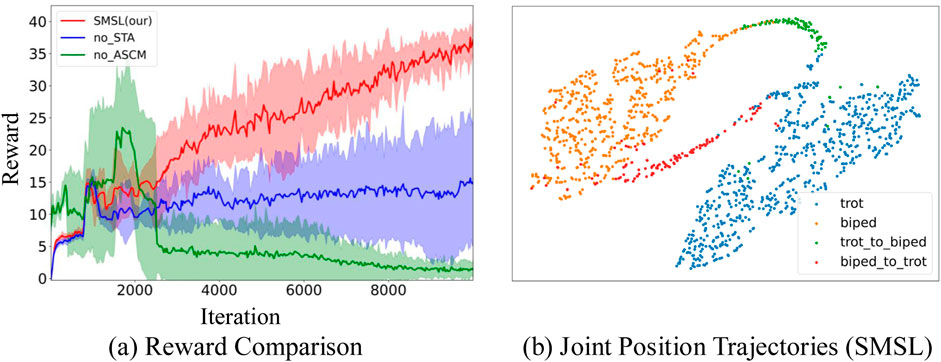
Figure 8. Performance display of the SMSL method. (a) Red represents the reward changes corresponding to each iteration of the SMSL method. Blue represents the reward changes with the STA method removed. Green represents the reward changes with the ASCM method removed. (b) Orange represents bipedal walking, blue represents quadrupedal walking, green represents transitions from quadrupedal to bipedal states, and red represents transitions from bipedal to quadrupedal states.
Figure 8b provides a T-SNE visualization that offers an intuitive representation, showcasing the joint trajectories for quadrupedal walking (trot, represented in blue) and bipedal walking (biped, represented in orange), as well as the transitions between them (represented in red and green). The joint trajectories for quadrupedal and bipedal walking are distinctly separated on the T-SNE plot, highlighted in blue and orange, respectively. This demonstrates that the SMSL method can effectively learn different motor skills from a Non-similar expert dataset. The red and green trajectories illustrate the transition actions between the two walking states, connecting the quadrupedal and bipedal trajectories. This indicates that the SMSL method not only learns individual motor skills but also generates seamless transitions between skills. In summary, the T-SNE plot in Figure 8b provides compelling visual evidence of the SMSL method’s powerful capability in multi-skill learning, particularly in handling Non-similar skills and their transitions.
6 Conclusion
We propose Seamless Multi-Skill Learning (SMSL) method, designed to enable a quadruped robot to learn Non-similar skills and their natural transitions from an incomplete, unlabeled expert dataset. This approach effectively simplifies the preparation phase of the expert dataset in multi-skill learning, reducing the complexity of the preparatory work. SMSL is based on the analysis of joint position information of robotic motion skills, utilizing this data for effective IL. A key advantage of this approach is its independence from the similarity between skills, it can achieve effective IL even when there is a significant difference between skills. This flexibility allows the agent to learn and adapt more comfortably when faced with a diverse set of skills. Additionally, SMSL places a strong emphasis on balancing the opportunities for skill training. Through this approach, we prevent the agent from falling into the trap of local optima during the learning process, ensuring global optimization. This balanced strategy helps the agent to master a comprehensive range of skills when faced with complex tasks, rather than being limited to a specific skill.
Experimental validation has demonstrated that our method significantly enhances the robustness of IL approaches. SMSL outperforms existing baseline methods in terms of the agent’s survival rate and the stability of skill-to-command mapping. These results indicate that SMSL has high practicality and effectiveness in real-world applications, especially in complex environments where an agent needs to flexibly switch between multiple skills.
SMSL significantly enhances the performance of quadruped robots in IL by simplifying the preparation process of expert datasets, enhancing the flexibility of skill learning, and balancing opportunities for skill training. These improvements not only increase the adaptability of agents in complex tasks but also bolster their robustness when facing new challenges.
Although our proposed method demonstrated significant potential in both simulated environments and experiments, we observed some challenges during the transition from simulation to real-world application. Specifically, the robot exhibited strong robustness in the quadrupedal state, while the bipedal state showed less stable movement. We conducted a detailed analysis of this phenomenon and identified several possible causes.
Here are several main directions for our future work:
Data availability statement
The original contributions presented in the study are included in the article/Supplementary Material, further inquiries can be directed to the corresponding authors.
Author contributions
JT: Conceptualization, Methodology, Software, Validation, Visualization, Writing – original draft. PZ: Conceptualization, Supervision, Writing – review and editing. YZ: Methodology, Software, Writing – review and editing. XW: Software, Visualization, Writing – original draft. ZD: Supervision, Writing – review and editing. LZ: Formal Analysis, Supervision, Writing – review and editing.
Funding
The author(s) declare that no financial support was received for the research and/or publication of this article.
Conflict of interest
The authors declare that the research was conducted in the absence of any commercial or financial relationships that could be construed as a potential conflict of interest.
Generative AI statement
The author(s) declare that no Generative AI was used in the creation of this manuscript.
Publisher’s note
All claims expressed in this article are solely those of the authors and do not necessarily represent those of their affiliated organizations, or those of the publisher, the editors and the reviewers. Any product that may be evaluated in this article, or claim that may be made by its manufacturer, is not guaranteed or endorsed by the publisher.
Supplementary material
The Supplementary Material for this article can be found online at: https://www.frontiersin.org/articles/10.3389/frobt.2025.1542692/full#supplementary-material
References
Aziz, H., Pal, A., Pourmiri, A., Ramezani, F., and Sims, B. (2022). Task allocation using a team of robots. Curr. Robot. Rep. 3, 227–238. doi:10.1007/s43154-022-00087-4
Billard, A., Calinon, S., Dillmann, R., and Schaal, S. (2008). Survey: robot programming by demonstration. Springer handbook of robotics, 1371–1394.
Cao, X., Luo, F.-M., Ye, J., Xu, T., Zhang, Z., and Yu, Y. (2024). “Limited preference aided imitation learning from imperfect demonstrations,” in Forty-first international conference on machine learning.
Escontrela, A., Peng, X. B., Yu, W., Zhang, T., Iscen, A., Goldberg, K., et al. (2022). Adversarial motion priors make good substitutes for complex reward functions, 25, 32. doi:10.1109/iros47612.2022.9981973
Gavenski, N., Rodrigues, O., and Luck, M. (2024). Imitation learning: a survey of learning methods, environments and metrics. arXiv Prepr. doi:10.48550/arXiv.2404.19456
Goodfellow, I., Pouget-Abadie, J., Mirza, M., Xu, B., Warde-Farley, D., Ozair, S., et al. (2020). Generative adversarial networks. Commun. ACM 63, 139–144. doi:10.1145/3422622
Grimminger, F., Meduri, A., Khadiv, M., Viereck, J., Wüthrich, M., Naveau, M., et al. (2020). An open torque-controlled modular robot architecture for legged locomotion research. IEEE Robotics Automation Lett. 5, 3650–3657. doi:10.1109/lra.2020.2976639
Ho, J., and Ermon, S. (2016). Generative adversarial imitation learning. Adv. neural Inf. Process. Syst. 29. doi:10.5555/3157382.3157608
Hou, T., Tu, J., Gao, X., Dong, Z., Zhai, P., and Zhang, L. (2024). Multi-task learning of active fault-tolerant controller for leg failures in quadruped robots. arXiv Prepr. arXiv:2402.08996, 9758–9764. doi:10.1109/icra57147.2024.10610151
Hussein, A., Gaber, M. M., Elyan, E., and Jayne, C. (2017). Imitation learning: a survey of learning methods. ACM Comput. Surv. (CSUR) 50, 1–35. doi:10.1145/3054912
Kumar, A., Fu, Z., Pathak, D., and Malik, J. (2021). Rma: rapid motor adaptation for legged robots. arXiv preprint arXiv:2107.04034
Lan, L.-C., Zhang, H., and Hsieh, C.-J. (2023). Can agents run relay race with strangers? generalization of rl to out-of-distribution trajectories
Lee, J., Hwangbo, J., Wellhausen, L., Koltun, V., and Hutter, M. (2020). Learning quadrupedal locomotion over challenging terrain. Sci. robotics 5, eabc5986. doi:10.1126/scirobotics.abc5986
Léziart, P.-A. (2022). Locomotion control of a lightweight quadruped robot. Toulouse, France: Université Paul Sabatier-Toulouse III. Ph.D. thesis.
Li, C., Blaes, S., Kolev, P., Vlastelica, M., Frey, J., and Martius, G. (2023). “Versatile skill control via self-supervised adversarial imitation of unlabeled mixed motions,” in 2023 IEEE international conference on robotics and automation (ICRA) (IEEE), 2944–2950.
Li, C., Vlastelica, M., Blaes, S., Frey, J., Grimminger, F., and Martius, G. (2022). Learning agile skills via adversarial imitation of rough partial demonstrations
Lin, L.-J. (1992). Self-improving reactive agents based on reinforcement learning, planning and teaching. Mach. Learn. 8, 293–321. doi:10.1007/bf00992699
Makoviychuk, V., Wawrzyniak, L., Guo, Y., Lu, M., Storey, K., Macklin, M., et al. (2021). Isaac gym: high performance gpu-based physics simulation for robot learning
Messikommer, N., Song, Y., and Scaramuzza, D. (2024). Contrastive initial state buffer for reinforcement learning, 2866, 2872. doi:10.1109/icra57147.2024.10610528
Miki, T., Lee, J., Hwangbo, J., Wellhausen, L., Koltun, V., and Hutter, M. (2022). Learning robust perceptive locomotion for quadrupedal robots in the wild. Sci. robotics 7, eabk2822. doi:10.1126/scirobotics.abk2822
Mnih, V., Kavukcuoglu, K., Silver, D., Rusu, A. A., Veness, J., Bellemare, M. G., et al. (2015). Human-level control through deep reinforcement learning. nature 518, 529–533. doi:10.1038/nature14236
Peng, X. B., Kanazawa, A., Malik, J., Abbeel, P., and Levine, S. (2018). Sfv: reinforcement learning of physical skills from videos. ACM Trans. Graph. (TOG) 37, 1–14. doi:10.1145/3272127.3275014
Peng, X. B., Ma, Z., Abbeel, P., Levine, S., and Kanazawa, A. (2021). Amp: adversarial motion priors for stylized physics-based character control. ACM Trans. Graph. (ToG) 40, 1–20. doi:10.1145/3450626.3459670
Rajaraman, N., Yang, L., Jiao, J., and Ramchandran, K. (2020). Toward the fundamental limits of imitation learning. Adv. Neural Inf. Process. Syst. 33, 2914–2924. doi:10.5555/3495724.3495969
Ran, C., and Su, J. (2024). Task-oriented self-imitation learning for robotic autonomous skill acquisition. Int. J. Humanoid Robotics 21, 2450001. doi:10.1142/s0219843624500014
Schaul, T., Quan, J., Antonoglou, I., and Silver, D. (2015). Prioritized experience replay. arXiv preprint arXiv:1511.05952
Schulman, J., Wolski, F., Dhariwal, P., Radford, A., and Klimov, O. (2017). Proximal policy optimization algorithms
Sutton, R. S., and Barto, A. G. (2018). Reinforcement learning: an introduction. Cambridge: MIT press, 1998.
Torabi, F., Warnell, G., and Stone, P. (2019). Recent advances in imitation learning from observation. 6325, 6331. doi:10.24963/ijcai.2019/882
Vollenweider, E., Bjelonic, M., Klemm, V., Rudin, N., Lee, J., and Hutter, M. (2023). “Advanced skills through multiple adversarial motion priors in reinforcement learning,” in 2023 IEEE international conference on robotics and automation (ICRA) (IEEE), 5120–5126.
Wu, J., Xin, G., Qi, C., and Xue, Y. (2023). Learning robust and agile legged locomotion using adversarial motion priors. IEEE Robotics Automation Lett. 8, 4975–4982. doi:10.1109/lra.2023.3290509
Yang, Y., Chen, G., Hao, J., and Heng, P.-A. (2024). “Sample-efficient multiagent reinforcement learning with reset replay,” in Forty-first international conference on machine learning.
Keywords: multi-skill learning, imitation learning, adaptive command sampling, self-trajectory augmentation, quadrupedal robots
Citation: Tu J, Zhai P, Zhang Y, Wei X, Dong Z and Zhang L (2025) Seamless multi-skill learning: learning and transitioning non-similar skills in quadruped robots with limited data. Front. Robot. AI 12:1542692. doi: 10.3389/frobt.2025.1542692
Received: 10 December 2024; Accepted: 21 April 2025;
Published: 30 April 2025.
Edited by:
Jun Ma, Hong Kong University of Science and Technology, Hong Kong SAR, ChinaReviewed by:
Konstantinos Chatzilygeroudis, University of Patras, GreeceChunbiao Gan, Zhejiang University, China
Copyright © 2025 Tu, Zhai, Zhang, Wei, Dong and Zhang. This is an open-access article distributed under the terms of the Creative Commons Attribution License (CC BY). The use, distribution or reproduction in other forums is permitted, provided the original author(s) and the copyright owner(s) are credited and that the original publication in this journal is cited, in accordance with accepted academic practice. No use, distribution or reproduction is permitted which does not comply with these terms.
*Correspondence: Peng Zhai, cHpoYWlAZnVkYW4uZWR1LmNu; Lihua Zhang, bGlodWF6aGFuZ0BmdWRhbi5lZHUuY24=
 Jiaxin Tu
Jiaxin Tu Peng Zhai*
Peng Zhai*


